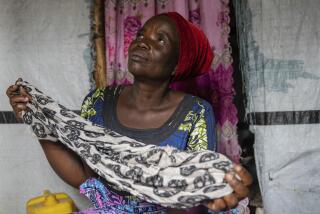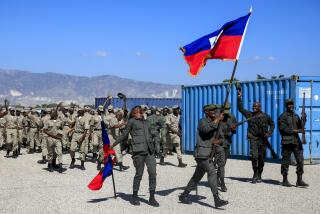Child Soldiers Used Widely, Report Finds
UNITED NATIONS — Jimmy Tamba, 18, can’t remember how many people he killed after rebels abducted him as a 13-year-old into their army in Sierra Leone. Or perhaps he just won’t. Now that there is a moment of peace in his country, his fight is to put his childhood of violence behind him and reclaim a normal life.
“On the outside, we seem OK,” he says of his fellow child soldiers, now living in a group home in Sierra Leone’s capital, Freetown. “But on the inside”--he pauses--”so many problems.”
According to a report released Tuesday, as many as 300,000 children in 41 countries are actively fighting. Most are teenagers, but some are as young as 7. As long as they are big enough to hold a light machine gun, they can be killers on the front lines.
“One of the most disturbing trends is the fact that children are being recruited because of their value as children, rather than because there is a shortage of adults,” said Rory Mungoven, a coordinator of the Coalition to Stop the Use of Child Soldiers, which put together the 450-page report. “Children are being recruited because they are cheap, because they are expendable,” and because they are easier to manipulate and transport across borders, Mungoven said.
The six-member London-based coalition includes Human Rights Watch, Amnesty International and World Vision.
Youths Have Trouble Reentering Society
The use of children as soldiers begets a special kind of terror: Once some become fighters, then all children in that area become suspect. The report cites an instance in Colombia in August in which an army unit killed a group of elementary school children, mistaking them for a guerrilla unit.
One of the biggest challenges is removing youths from a cycle of violence and easing them back into normalcy.
“I lost my parents in the war, and friends of mine watched their parents killed in front of them,” said Ishmael Beah, 19, who joined Sierra Leone’s army at 14, convinced by officers that it was the best way to avenge his parents’ deaths. He fought for three years against the Revolutionary United Front rebels who had abducted Tamba into their ranks. “I realized that as part of the military, you kill other people’s parents. Then they in turn are going to join the RUF to get revenge for the death of their parents.”
After a cease-fire, Beah spent seven months in rehabilitation outside Freetown and was ultimately adopted by a New York foster family he met at a U.N. conference. He just finished his first year at Oberlin College in Ohio.
But not many are as lucky as Beah, who, along with Tamba, spoke at the United Nations on Tuesday. When wars subside, there are few choices for children who spent their youth behind artillery instead of school desks. They tend to have trouble reentering society, finding jobs and controlling their aggression.
Father Giuseppe Berton, a Catholic priest who has lived in Sierra Leone for 32 years, started the Family Homes Movement in 1997 to help war-scarred children. He used to kidnap children back from the rebels a few at a time; Tamba came to him after a temporary cease-fire.
Thanks to a recent peace agreement, nearly 1,000 child soldiers have been released by the country’s rebels since the end of May, and the capital is suddenly flooded with displaced children. But Berton says the people of Freetown are afraid of the youths, seeing them as murderous guerrillas, not teenagers who need help.
Too Soon to Know the Long-Term Effects
The trauma of being forced to kill is often too deep to measure, and it is too soon to gauge the long-term effects, Berton said.
Because it is easier to prevent the loss of a generation than to reclaim one, the coalition is pushing for all countries to ratify a May 2000 U.N. treaty banning the forced recruitment and participation of children younger than 18 in armed conflict. The immediate goal is 100 ratifications before a special U.N. session on children in September. So far, 80 countries have signed the protocol, including the U.S., but only five have ratified it. The problem is not confined to developing countries: The U.S. allows 17-year-olds in combat and deployed them in the Persian Gulf War, Somalia and the Balkans. Britain is the only country in Europe to recruit 16-year-olds.
In the U.S. and Britain, however, most soldiers can choose whether to enlist. In trouble spots such as Africa and, increasingly, Asia, most kids who end up in combat have little choice.
When she was 13, Agnes Gillian Ocitti was asleep in her boarding school in Uganda when rebels came in the night and kidnapped 140 students to send to Sudan as soldiers. They forced the girls to kill one of their classmates who tried to escape. After three months, Ocitti and a friend took a chance and fled. They eventually returned to their families and their school, which is now protected by high walls and armed soldiers, but the students still lie awake at night, listening for the rebels’ return.
With international financing, a group of parents in her community started a counseling program for the children, and she came to the U.N. this week to talk about it.
“They helped me to understand my suffering, and to turn my feelings from hatred to a chance to discover something about myself,” said the 18-year-old, playing with her long hair plaited in hundreds of tiny braids. “Before, I didn’t know what I wanted to do. Now I know I want to be a lawyer and help others who have suffered injustice.”
More to Read
Sign up for Essential California
The most important California stories and recommendations in your inbox every morning.
You may occasionally receive promotional content from the Los Angeles Times.










